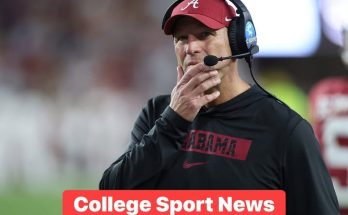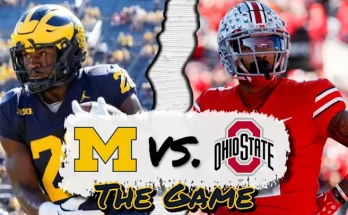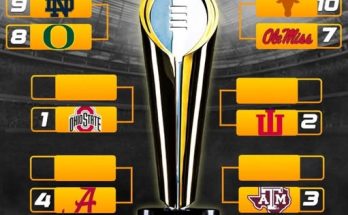Jeremiah Smith, a standout wide receiver for the Ohio State Buckeyes, has been a beacon of excellence in college football. His remarkable freshman season, marked by 71 receptions for 1,227 yards and 14 touchdowns, has solidified his reputation as one of the nation’s premier talents. However, recent reports have cast a shadow over his promising career. Allegations have surfaced suggesting that Smith suffered a devastating ACL injury during practice. This article delves into the implications of such an injury on Smith’s career, the Ohio State football program, and the broader college football landscape.
The Rise of Jeremiah Smith
Jeremiah Smith’s journey to Ohio State was nothing short of extraordinary. Hailing from Hollywood, Florida, he was a consensus five-star recruit, lauded for his exceptional speed, agility, and football IQ. His high school career was illustrious, setting numerous records and earning accolades that highlighted his potential to excel at the collegiate level.
Upon joining Ohio State, Smith made an immediate impact. His 71 receptions, 1,227 receiving yards, and 14 touchdowns were instrumental in the Buckeyes’ offensive success. His performance in the Rose Bowl against the Oregon Ducks, where he amassed 187 yards and two touchdowns, further cemented his status as a rising star in college football.
The Alleged Injury
The recent reports of Smith’s alleged ACL injury have sent shockwaves through the college football community. While details remain scarce, the implications of such an injury are profound. An anterior cruciate ligament (ACL) tear is a severe injury that often requires surgical intervention and a lengthy rehabilitation period. For a wide receiver like Smith, whose game relies heavily on speed and agility, an ACL injury can be particularly devastating.
Implications for Jeremiah Smith
If the reports are accurate, Smith faces a challenging road ahead. The recovery process for an ACL injury typically spans several months, during which the athlete undergoes physical therapy to restore strength and mobility. The psychological impact of such an injury can also be significant, as athletes grapple with the uncertainty of their return to peak performance.
For Smith, this injury could affect his draft prospects. As a freshman, he is not yet eligible for the NFL Draft. However, the injury could influence his decision to declare for the draft in the future, depending on his recovery and performance.
Implications for Ohio State Football
Ohio State’s football program has been a powerhouse in college football, consistently producing top-tier talent and competing for national championships. The loss of a player of Smith’s caliber would be a significant blow to the team’s offensive strategy. His ability to stretch the field and make explosive plays has been a cornerstone of the Buckeyes’ success.
In the short term, the coaching staff would need to adjust their game plans to compensate for Smith’s absence. This could involve increased reliance on other receivers and adjustments to the offensive scheme to maintain effectiveness.
Broader Implications
The potential injury to Smith also highlights the inherent risks associated with the sport of football. Despite advancements in training, equipment, and medical care, injuries remain an unfortunate aspect of the game. This incident serves as a reminder of the fragility of athletic careers and the resilience required to overcome such setbacks.
Recovery Process and Road Ahead
If Jeremiah Smith’s ACL injury is confirmed, his recovery journey will be long and challenging. For athletes, an ACL tear is one of the most significant injuries they can face, and its recovery demands patience, hard work, and determination. Following surgery, Smith will likely face an intense rehabilitation process, which can take anywhere from 6 to 12 months, depending on the severity of the injury and his body’s response to treatment.
The first phase of recovery typically involves reducing swelling and pain through physical therapy and anti-inflammatory medications. The focus is on regaining the knee’s range of motion and preventing muscle atrophy that can occur from being immobilized. As recovery progresses, Smith will likely begin strength training exercises aimed at restoring the stability and strength of his knee and surrounding muscles.
For a wide receiver like Smith, whose success relies heavily on explosive movements like sharp cuts, acceleration, and quick changes in direction, a comprehensive rehabilitation plan is critical. The road to full recovery can be mentally taxing as well. Not only does Smith need to physically get back to peak performance, but he also needs to regain confidence in his body and his ability to perform at the elite level required for professional football.
There have been notable examples of players who have successfully overcome ACL injuries and returned to their previous form, and this could serve as motivation for Smith. Players like Adrian Peterson, who famously returned from an ACL tear to win an MVP award just months after his surgery, have proven that with the right mindset and approach, it is possible to not only return but also to excel.
However, the psychological element cannot be underestimated. ACL injuries often cause athletes to fear re-injury, which can affect their performance on the field. In Smith’s case, the key will be his mental strength and his commitment to the grueling rehabilitation process. If he can work through the mental hurdles, there is a good chance that he can return to form, although there may be lingering concerns about long-term durability.
Impact on Ohio State’s Offense
Jeremiah Smith’s role in Ohio State’s offense cannot be overstated. His combination of speed, agility, and size made him a nightmare for opposing defenses. He was the go-to target for quarterback Kyle McCord, and his ability to stretch the field and create mismatches was a key component of the Buckeyes’ high-powered offense.
Without Smith, Ohio State would face an uphill battle in terms of maintaining their offensive potency. The Buckeyes have a talented roster, but Smith’s absence leaves a significant void. The wide receiver group at Ohio State is deep, but few have the same combination of skills and athleticism that Smith possesses. The coaching staff would need to rely on players like Marvin Harrison Jr., who has the potential to step up as the team’s top receiver, and others like Emeka Egbuka and Julian Fleming, to assume a greater share of the load.
Ohio State’s offensive coordinator, Brian Hartline, would need to adjust the playbook to account for Smith’s absence. The team might shift to a more run-heavy attack or look for different ways to exploit matchups in the passing game. Hartline is known for his innovative offensive schemes, and it would be interesting to see how he adapts to the loss of one of the best wide receivers in the nation.
Moreover, Ohio State’s quarterback play could also be impacted by Smith’s injury. Quarterbacks like McCord, who rely on dynamic receivers to make plays downfield, would need to adjust their timing and decision-making without their star wideout. The chemistry between McCord and Smith was vital to Ohio State’s offensive success, and replacing that chemistry would take time and development with other receivers.
The Larger Context: ACL Injuries in College Football
Jeremiah Smith’s injury shines a spotlight on the high-risk nature of football, particularly for players who rely on their legs for speed and agility. ACL injuries have become increasingly common in football, especially at the college level. As training and competition intensify, so too does the physical demand placed on players’ bodies. With the increasing size and speed of players, the strain on joints, particularly the knees, has led to more injuries in recent years.
For college athletes like Smith, who are playing in one of the most physically demanding sports in the world, there are also concerns about the long-term impact of such injuries. While the medical field has made great strides in treating ACL tears, the reality is that returning to top-tier competition can be difficult, and some players never fully regain their previous level of performance.
Moreover, the pressure to recover quickly and return to the field often leads to athletes pushing themselves too hard, risking further injury. College football programs, including Ohio State, have become more mindful of the mental and emotional support that athletes need during recovery. This holistic approach to recovery helps players regain not just their physical health, but their mental well-being as well, which is vital to a successful comeback.
Jeremiah Smith’s Legacy and the Future
Despite the setback, Jeremiah Smith’s future remains bright. If he recovers fully from his ACL injury, he still has the potential to be one of the best wide receivers in college football and a top pick in the NFL Draft. His physical tools, coupled with his ability to perform under pressure, set him apart as a future star at the next level.
The injury, however, could also serve as a turning point for Smith. Some players find their careers altered by such injuries, but others use them as fuel to push beyond their previous limits. There is no doubt that Smith has the talent, work ethic, and support system to overcome this challenge. With Ohio State’s medical staff and strength program behind him, he can focus on his recovery and come back even stronger.
For Ohio State fans, this injury is a reminder of how fragile success can be in the world of college football. The team’s hopes for a national championship run in the upcoming season may now rest on the ability of other players to step up and fill the gap left by Smith’s absence. Whether or not Ohio State can adapt to life without Smith will likely define their season, but it’s clear that the Buckeyes have the talent and depth to make the necessary adjustments.
Conclusion
In the world of college football, talent like Jeremiah Smith’s comes around once in a generation. His skills, both as a wide receiver and as a leader, have the potential to reshape the future of Ohio State’s football program and the NFL. While his reported ACL injury is a devastating setback, it also serves as a reminder of the inherent risks of the game and the resilience required to succeed at the highest level.
As fans, we can only hope that Smith’s recovery is swift and successful, and that he will be able to return to the field and continue to showcase the exceptional talent that has made him one of the most exciting players in college football today. His journey, both through injury and recovery, will undoubtedly serve as an inspiration to countless athletes who face similar challenges. The road ahead may be difficult, but with determination and perseverance, Smith has the potential to emerge stronger than ever.



